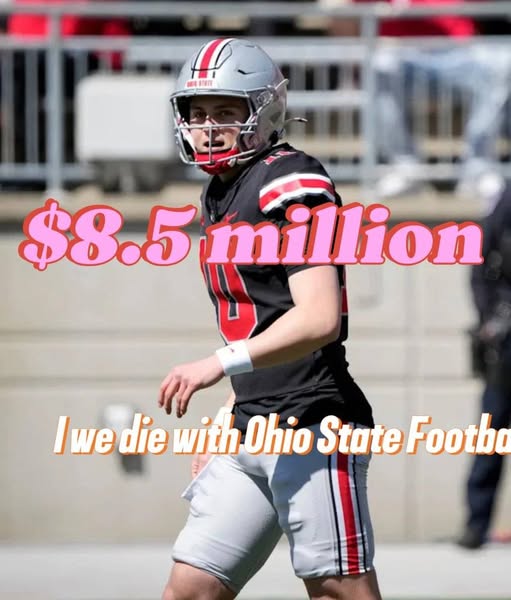In a world where college athletes increasingly capitalize on their name, image, and likeness (NIL) opportunities, Ohio State quarterback Julian Sayin’s recent decision stands out as a remarkable testament to loyalty, character, and an unwavering belief in building a lasting legacy. Sayin, one of the most sought-after quarterback prospects in the country, made headlines when he reportedly turned down a staggering $8.5 million NIL deal from USC, choosing instead to remain committed to the Buckeyes. This decision is as much about faith in his team’s championship aspirations as it is about honoring the tradition and culture of Ohio State football.
The landscape of college football has been transformed in recent years by NIL agreements, which have empowered players to monetize their personal brands. High-profile programs such as USC have aggressively pursued elite talent with lucrative NIL offers, often dwarfing what many athletes previously imagined possible. For Julian Sayin, receiving such a monumental offer was undoubtedly tempting — the kind of financial opportunity that can be life-changing. Yet, in the end, the allure of a massive payout did not sway him from his commitment to Ohio State.
Sayin’s journey to this crossroads has been marked by excellence, discipline, and a deep connection to the Buckeye program. Recruited as a top-tier quarterback, he has drawn comparisons to some of the greatest signal-callers to ever wear Ohio State’s scarlet and gray. His talent on the field is matched by an equally impressive maturity off it — a maturity that has clearly guided his decision-making process. This move sends a powerful message about what matters most to him: not just individual gain, but team success and legacy.
Choosing loyalty in today’s NIL-driven world is no small feat. Many young athletes feel pressure to seize every dollar opportunity that comes their way, especially when offers are astronomical. The fact that Sayin resisted this pressure demonstrates his commitment to a greater cause. He believes in Ohio State’s ability to contend for national championships and is willing to put that faith above personal financial gain. It’s a decision that echoes the old-school values of college football — where pride in one’s program and the pursuit of collective glory trump everything else.
Ohio State’s football program is no stranger to greatness. With a rich history of national championships, legendary coaches, and NFL-caliber players, the Buckeyes represent a powerhouse in college football. For Sayin, being part of this storied tradition is something he values deeply. He recognizes that his time at Ohio State is an opportunity to build something special, to leave a mark on the program that will be remembered long after his playing days are over.
Furthermore, Sayin’s decision highlights a significant shift in how athletes view their collegiate careers. While NIL deals provide financial benefits, not every player sees them as the defining factor in where they play. For some, the chance to compete for championships, to develop under elite coaching staffs, and to build lifelong relationships holds far more significance. Sayin’s stance reflects this perspective, emphasizing that NIL money is only one piece of the puzzle in the overall college experience.
The quarterback’s loyalty also speaks volumes about his character and leadership qualities. Quarterbacks are often judged not just by their physical skills but by their mental toughness, decision-making, and ability to inspire teammates. Sayin’s choice to reject a lucrative NIL offer in favor of team unity and shared goals demonstrates a leadership mindset that will undoubtedly resonate with his coaches and teammates. It sends a clear signal that he is invested in the team’s success above all else.
The reaction from the Ohio State community has been overwhelmingly positive. Fans, coaches, and alumni alike have praised Sayin for his integrity and commitment. In an era when loyalty can sometimes feel scarce in college sports, his decision feels refreshing and inspiring. It reinforces the belief that the Buckeyes are not just a football team but a family united by common values and aspirations.
On the flip side, USC’s NIL offer was undoubtedly a strategic move to try and sway one of the nation’s top quarterback prospects. Trojans fans and boosters have made no secret of their desire to reclaim their status as a college football juggernaut. Offering $8.5 million was a bold statement about how serious they are about competing for elite talent. However, Sayin’s refusal to be tempted highlights that while money matters, it is not the only factor for players who want more than just a paycheck—they want purpose and meaning in their college careers.
The broader implications of Sayin’s choice extend beyond Ohio State and USC. It sparks a discussion about the evolving nature of college athletics, NIL deals, and what motivates athletes today. While some critics argue that NIL could turn college sports into a marketplace where loyalty is secondary to cash, Sayin’s example shows that values still hold weight. Athletes are capable of making decisions that prioritize legacy, team culture, and personal growth over immediate financial reward.
In terms of his future, Sayin’s decision may well pay dividends both on and off the field. By staying at Ohio State, he positions himself to compete at the highest level, improve under renowned coaches, and potentially lead the Buckeyes to a national title. Success in college football often translates to NFL opportunities, and by building his brand through performance and leadership, Sayin may unlock even greater NIL potential in the years ahead. His decision might even inspire other recruits to weigh their options more carefully, balancing financial offers against the intangible benefits of loyalty and championship dreams.
Moreover, this decision underscores the importance of a supportive environment for athletes. Ohio State’s coaching staff, administration, and fan base clearly played a role in reinforcing Sayin’s commitment. They fostered a culture that values tradition, hard work, and team success, which undoubtedly resonated with him. It serves as a reminder to all programs that cultivating a positive culture and clear vision can be just as effective in recruiting and retaining talent as flashy NIL deals.
As the college football season approaches, all eyes will be on Julian Sayin to see how he translates this commitment into on-field success. His story has already captured the imagination of fans and analysts nationwide. Will this sense of loyalty and purpose propel him and the Buckeyes to championship glory? The foundation is certainly there.
In conclusion, Julian Sayin’s rejection of an $8.5 million NIL deal from USC in favor of staying loyal to Ohio State is a remarkable example of character, maturity, and belief in something bigger than individual gain. It speaks to the enduring power of college football traditions, the value of team unity, and the pursuit of championships over cash. In an era of rapid change and increasing commercialization in college sports, Sayin’s decision is a powerful reminder that loyalty and legacy still matter—and can shine even brighter than the biggest paycheck.



